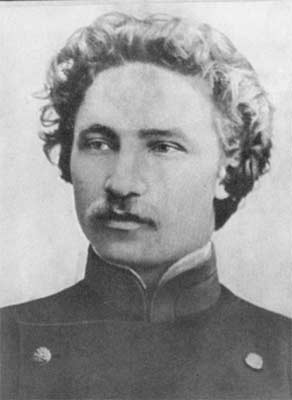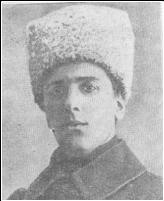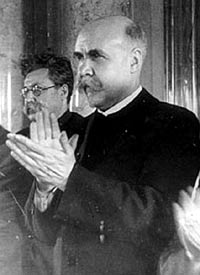|
7th Army (RSFSR)
The 7th Army was a field army of the Red Army during the Russian Civil War, which existed between November 1918 and February 1920. History The 7th Army was formed on November 1, 1918 from the units of the former Olonets group of troops, the 2nd Petrograd Infantry Division and the Pskov Rifle Division. It was part of the Northern Front which fought against Entente troops and the White Northern Army which were based in Archangelsk and Murmansk. After the disbandment of Northern Front the 7th Army was transferred to the Western Front. The 7th Army also took part in the Soviet campaign against Estonia. On November 22, 1918, units of the 7th Army attacked Narva for the first time, but the assault was repulsed by the German troops still remaining in the city. A week later, the Soviet troops seized the city. Then the troops of the 7th Army began to advance westward, and by early January 1919 they were 35 kilometers from Tallinn. But on January 7, 1919, the Estonian 1st division l ... [...More Info...] [...Related Items...] OR: [Wikipedia] [Google] [Baidu] |
Red Army
The Workers' and Peasants' Red Army (Russian: Рабо́че-крестья́нская Кра́сная армия),) often shortened to the Red Army, was the army and air force of the Russian Soviet Federative Socialist Republic and, after 1922, the Union of Soviet Socialist Republics. The army was established in January 1918. The Bolsheviks raised an army to oppose the military confederations (especially the various groups collectively known as the White Army) of their adversaries during the Russian Civil War. Starting in February 1946, the Red Army, along with the Soviet Navy, embodied the main component of the Soviet Armed Forces; taking the official name of "Soviet Army", until its dissolution in 1991. The Red Army provided the largest land force in the Allied victory in the European theatre of World War II, and its invasion of Manchuria assisted the unconditional surrender of Imperial Japan. During operations on the Eastern Front, it accounted for 75–80% of casual ... [...More Info...] [...Related Items...] OR: [Wikipedia] [Google] [Baidu] |
Yamburg
Kingisepp (russian: Ки́нгисепп or ), formerly Yamburg (), Yam (), and Yama (; Votic: ), is an ancient town and the administrative center of Kingiseppsky District of Leningrad Oblast, Russia, located along the Luga River southwest of St. Petersburg, east of Narva, and south of the Gulf of Finland. Population: History 14th century The town was first documented in 1384, when the Novgorodians under Patrikas built there a fortress against the Swedes. It was called Yama or Yamsky Gorodok, after the Izhorian (ethnic Finnic group) name Jaama. The environs of the town are still cited as the main location of speakers of the nearly extinct Izhorian language. The citadel withstood sieges by the Swedes in 1395 and by the Teutonic Knights during the 1444–1448 war. 15-16th century The town became the most important economic center of the of the Novgorod Republic. There were 201 homesteads in the 15th century in the town; its total population can only be evalua ... [...More Info...] [...Related Items...] OR: [Wikipedia] [Google] [Baidu] |
Soviet Field Armies In The Russian Civil War
The Soviet Union,. officially the Union of Soviet Socialist Republics. (USSR),. was a transcontinental country that spanned much of Eurasia from 1922 to 1991. A flagship communist state, it was nominally a federal union of fifteen national republics; in practice, both its government and its economy were highly centralized until its final years. It was a one-party state governed by the Communist Party of the Soviet Union, with the city of Moscow serving as its capital as well as that of its largest and most populous republic: the Russian SFSR. Other major cities included Leningrad (Russian SFSR), Kiev (Ukrainian SSR), Minsk (Byelorussian SSR), Tashkent (Uzbek SSR), Alma-Ata (Kazakh SSR), and Novosibirsk (Russian SFSR). It was the largest country in the world, covering over and spanning eleven time zones. The country's roots lay in the October Revolution of 1917, when the Bolsheviks, under the leadership of Vladimir Lenin, overthrew the Russian Provisional Government tha ... [...More Info...] [...Related Items...] OR: [Wikipedia] [Google] [Baidu] |
Mikhail Lashevich
Mikhail Mikhailovich Lashevich (russian: Михаил Михайлович Лашевич; 1884 in Odessa, Russian Empire – 30 August 1928 in Harbin, China), also known under the name ''Gaskovich'', was a Soviet military and party leader. Lashevich was born as Moisey Gaskovich into a Jewish merchant family in Odessa. He joined the Russian Social Democratic Labour Party in 1901 and after the split of 1903 adhered with the Bolshevik faction."Lashevich Mikhail Mikhailovich" He was conscripted into the Imperial Russian Army during the First World War and was twice wounded. After the , he went to St. Petersburg, where he opposed the decision of ... [...More Info...] [...Related Items...] OR: [Wikipedia] [Google] [Baidu] |
Nikolai Podvoisky
Nikolai Ilyich Podvoisky (russian: Николай Ильич Подвойский; February 16 Old_Style_and_New_Style_dates">O.S_February_4.html" ;"title="Old_Style_and_New_Style_dates.html" ;"title="nowiki/>O.S_February_4">Old_Style_and_New_Style_dates.html"_;"title="nowiki/>Old_Style_and_New_Style_dates">O.S_February_4_1880_–_July_28,_1948)_was_a_Russian_O.S_February_4">Old_Style_and_New_Style_dates.html"_;"title="nowiki/>Old_Style_and_New_Style_dates">O.S_February_4_1880_–_July_28,_1948)_was_a_Russian_Bolsheviks">Bolshevik_revolutionary,_Soviet_Union.html" "title="Bolsheviks.html" "title="Old Style and New Style dates">O.S February 4">Old_Style_and_New_Style_dates.html" ;"title="nowiki/>Old Style and New Style dates">O.S February 4 1880 – July 28, 1948) was a Russian Bolsheviks">Bolshevik revolutionary, Soviet Union">Soviet statesman and the first People's Commissar of Military and Naval Affairs of the Russian SFSR. He played a large role in the Russian R ... [...More Info...] [...Related Items...] OR: [Wikipedia] [Google] [Baidu] |
Grigory Zinoviev
Grigory Yevseyevich Zinoviev, . Transliterated ''Grigorii Evseevich Zinov'ev'' according to the Library of Congress system. (born Hirsch Apfelbaum, – 25 August 1936), known also under the name Ovsei-Gershon Aronovich Radomyslsky (russian: Овсей-Гершен Аронович Радомысльски, links=no), was a Soviet Union, Soviet revolutionary and politician. He was an Old Bolshevik and a close associate of Vladimir Lenin. During the 1920s, Zinoviev was one of the most influential figures in the Soviet leadership and the chairman of the Communist International. Born in Ukraine to a Jewish family, Zinoviev began revolutionary activities by joining the underground Russian Social Democratic Labour Party (RSDLP) in 1901. In 1903 the RSDLP split between the Mensheviks, Menshevik faction led by Julius Martov and the Bolsheviks led by Vladimir Lenin. Zinoviev joined Lenin's faction and in doing so he became one of the original Bolsheviks. As a Bolshevik, Zinoviev engaged i ... [...More Info...] [...Related Items...] OR: [Wikipedia] [Google] [Baidu] |
Arkady Rosengolts
Arkady Pavlovich Rosengolts (Russian: Арка́дий Па́влович Розенго́льц; 4 November 1889 – 15 March 1938; sometimes spelled Rosengoltz or Rosenholz) was a Bolshevik revolutionary, Soviet military leader, politician and diplomat. He was the People's Commissar of Foreign Trade and a defendant at the Moscow Trial of the Twenty-One in 1938. Early life Rosengolts was born in Vitebsk on November 4, 1889. He was the son of a Jewish merchant. Late in life, he said that he was raised by a woman who was an active revolutionary, and that at the age of ten, he had to hide illegal literature during a police raid. He joined the Bolshevik faction of the Russian Social-Democratic Workers' Party (RSDLP) in 1905, the year of the first, abortive Russian Revolution, and was arrested for the first at the age of 16. In 1906, he was a Bolshevik delegate to the Fourth RSDLP Congress, in Stockholm. He worked as an insurance agent and carried out work for the Bolshevik party ... [...More Info...] [...Related Items...] OR: [Wikipedia] [Google] [Baidu] |
Ivan Mezhlauk
Ivan Ivanovich Mezhlauk (russian: Иван Иванович Межлаук; lv, Jānis Mežlauks) (30 September 1891 – 25 April 1938) was a Soviet politician and statesman who was the first general secretary of the Communist Party of the Turkmen SSR as well as its first president. Ivan Mezhlauk was born in Kharkiv (modern Ukraine), in the Kharkov Governorate of the Russian Empire on 30 September 1891. He was of Latvian ethnicity. He joined the Bolshevik Party in 1918 and served in the Red Army during the Russian Civil War. He was president from 19 November 1924 until September 1925, when he was replaced with Khalmurad Sakhatmuradov. His term as general secretary lasted longer, until 1926. He was succeeded as general secretary by Shaymardan Ibragimov. From 1930 to 1933, Mezhlauk worked in the Soviet economic planning apparatus, for a time as the secretary of the Council of Labor and Defense.R.W. Davies, "Ivan Ivanovich Mezhlauk," in Archie Brown (ed.), ''The Soviet Union: A ... [...More Info...] [...Related Items...] OR: [Wikipedia] [Google] [Baidu] |
Boris Pozern
Boris Pavlovich Pozern (Russian: Борис Павлович Позерн; 7 July 1882 – 25 February 1939) was a Soviet politician and statesman and member of the Troika of the NKVD of the Soviet Union. Pozerb was born in Nizhny Novgorod to a family of German origin. He became a member of the Russian Social Democratic Labour Party in 1903. After the February Revolution, Pozern became the head of the Minsk Soviet. A member of the Russian Constituent Assembly of 1918. He was a member of the Central Committee elected by the 17th Congress of the All-Union Communist Party (Bolsheviks). During the Great Purge, he was arrested on 9 July 1938 and later executed by firing squad in Moscow. After the death of Joseph Stalin, he was rehabilitated in 1957. Works * ''Оппозиция на XV партконференции'' (Die Opposition auf der XV. Parteikonferenz) * Moskau und Leningrad 1928: ''Как оппозиция обороняет СССР'' (Wie die Opposition die Sowjet ... [...More Info...] [...Related Items...] OR: [Wikipedia] [Google] [Baidu] |
Dmitry Nikolayevich Nadyozhny
Dmitry Nikolayevich Nadyozhny (russian: Дмитрий Николаевич Надёжный; , Nizhny Novgorod - 22 February 1945, Moscow) was a commander in the Russian Imperial Army who later joined the Red Army. He rose to lieutenant general and fought in the First World War and Russian Civil War, commanding the Red Army's northern front in the latter. Early life Nadyozhny was born into a noble family from Nizhny Novgorod and graduated from the 1st Military Pavolvsky School in 1892. He was commissioned as a Lieutenant in the 14th Georgian grenadier regiment, and later transferred to the 10th Siberian Rifles. During the Russo-Japanese War he served as a staff captain and was awarded the Order of St George. Shortly before the outbreak of World War I he was a military adviser in Mongolia. World War I When the war began, Nadyozhny was assigned command of the 40th Kolyvan Infantry Regiment. In 1915 he was promoted to Major General, and by 1916 he was chief of staff to the 69th ... [...More Info...] [...Related Items...] OR: [Wikipedia] [Google] [Baidu] |
Mikhail Matiyasevich
Mikhail Stepanovich Matiyasevich (Matiasevich) (Smolensk, May 23 une 41878 – Kyiv, August 5, 1941) was a Soviet military commander, who commanded several military units of the Red Army during the Russian Civil War. Biography From the nobility of the Smolensk province, he fought in the Russo-Japanese War, as a lieutenant in the 220th Infantry Regiment. In the First World War, he fought on the Western and Northern fronts. He was wounded four times. Having become a Colonel in July 1916, he commanded the 717th Infantry Regiment. In the days of the October Revolution he was unanimously elected by the soldiers as commander of the Regiment. In February 1918 he was demobilized and apparently for ideological reasons, he voluntarily joined the Red Army in April 1918. He fought in the Russian civil war of 1918–1920, first at the head of the 1st Smolensk Infantry Division, then as commander of the right group of the 5th Army around Kazan and between November 14, 1918, and April 1919 ... [...More Info...] [...Related Items...] OR: [Wikipedia] [Google] [Baidu] |
Eugen Iskritsky
Yevgeni Andreyevich Iskritsky (August 15, 1874 – July 27, 1949) was a Russian Empire and Soviet military commander, author, teacher, a hero of the First World War, lieutenant general in the Imperial Russian army, who fell in with the winning side in the Russian Civil War yet was still a victim of Stalin's purges. Biography Yevgeni Andreyevich Iskritsky was born in 1874 in Starodub, Chernigov province, Russian Empire. He graduated from First Cadet Corps and advanced to the 1st Pavlovsk military college. He received his commission in 1892 as a Lieutenant in the 11th. Lifeguards 3 Artillery Brigade and Artillery Guards Rifle Division. In 1899, he graduated from Nikolaev General Staff Academy at the top of his class. In 1900–1901 he was a teacher of tactics and military history in Alexeyev military school. He served in the Propertied Command Company in the 12th Astrakhan Grenadier Regiment, as a senior aide in the headquarters of the 3rd Grenadier Division, as an assista ... [...More Info...] [...Related Items...] OR: [Wikipedia] [Google] [Baidu] |






